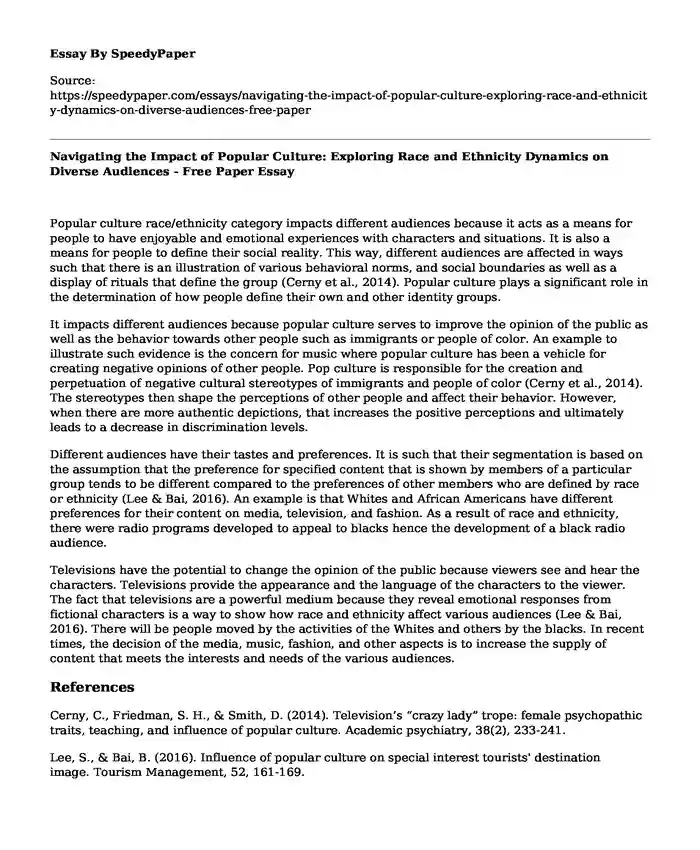Popular culture race/ethnicity category impacts different audiences because it acts as a means for people to have enjoyable and emotional experiences with characters and situations. It is also a means for people to define their social reality. This way, different audiences are affected in ways such that there is an illustration of various behavioral norms, and social boundaries as well as a display of rituals that define the group (Cerny et al., 2014). Popular culture plays a significant role in the determination of how people define their own and other identity groups.
It impacts different audiences because popular culture serves to improve the opinion of the public as well as the behavior towards other people such as immigrants or people of color. An example to illustrate such evidence is the concern for music where popular culture has been a vehicle for creating negative opinions of other people. Pop culture is responsible for the creation and perpetuation of negative cultural stereotypes of immigrants and people of color (Cerny et al., 2014). The stereotypes then shape the perceptions of other people and affect their behavior. However, when there are more authentic depictions, that increases the positive perceptions and ultimately leads to a decrease in discrimination levels.
Different audiences have their tastes and preferences. It is such that their segmentation is based on the assumption that the preference for specified content that is shown by members of a particular group tends to be different compared to the preferences of other members who are defined by race or ethnicity (Lee & Bai, 2016). An example is that Whites and African Americans have different preferences for their content on media, television, and fashion. As a result of race and ethnicity, there were radio programs developed to appeal to blacks hence the development of a black radio audience.
Televisions have the potential to change the opinion of the public because viewers see and hear the characters. Televisions provide the appearance and the language of the characters to the viewer. The fact that televisions are a powerful medium because they reveal emotional responses from fictional characters is a way to show how race and ethnicity affect various audiences (Lee & Bai, 2016). There will be people moved by the activities of the Whites and others by the blacks. In recent times, the decision of the media, music, fashion, and other aspects is to increase the supply of content that meets the interests and needs of the various audiences.
References
Cerny, C., Friedman, S. H., & Smith, D. (2014). Television’s “crazy lady” trope: female psychopathic traits, teaching, and influence of popular culture. Academic psychiatry, 38(2), 233-241.
Lee, S., & Bai, B. (2016). Influence of popular culture on special interest tourists' destination image. Tourism Management, 52, 161-169.
Cite this page
Navigating the Impact of Popular Culture: Exploring Race and Ethnicity Dynamics on Diverse Audiences - Free Paper. (2023, Dec 03). Retrieved from https://speedypaper.com/essays/navigating-the-impact-of-popular-culture-exploring-race-and-ethnicity-dynamics-on-diverse-audiences-free-paper
Request Removal
If you are the original author of this essay and no longer wish to have it published on the SpeedyPaper website, please click below to request its removal:
- Organizational Behavior Essay Sample
- Free Essay about Children in Lifeboats of the Titanic
- Free Essay Sample on the Epistemology of Modern Digital Media
- Free Essay. Definitions of deviant behavior
- Free Essay: Social Media Contributors to Fake News and Troll Armies
- Paper Example. Learning in Other Lands
- Free Paper: Infant Self-Regulation and Early Childhood Media Exposure
Popular categories





